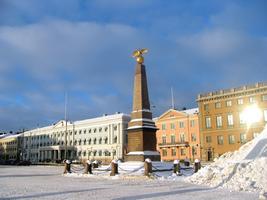| |  |
 |
 |
| artist |
Carl Ludvig Engel (1778 - 1840)
|
|
|
 |
| sculpture |
Keisarinnankivi / The Stone of The Empress |
|
|
 |
|
map | Market Square, Kaartinkaupunki |
| |
 |
| |
 |
| images |
Warning: Unable to open ../../ximg/keisarinnankivi01.jpg in /site/taidemuseo/www/include/statuehandler.php on line 136
1, 2 | |
|
|
'The Stone of the Empress' is the oldest public memorial in Helsinki. It was erected in the Market Square to commemorate the Empress Alexandra's (the German-born wife of Nicholas I), first visit to Helsinki. She visited the City in 1833 with her husband, who came to inspect the construction of Helsinki's new centre. The memorial is an obelisk cut in red granite. A bronze globe is set on top of the obelisk, and the two-headed eagle of Russia.
The obelisk form, already a basic memorial type for glorifying sculptures depicting historical events and in memorial stones during Antiquity in Europe was adopted for 'The Stone of the Empress'. This work is typical of the early 19th century obelisks which followed the traditions of the Antique forms.
The stone includes the following, explanatory texts in Finnish and Latin: "Keisarinna Alexandralle Suomen pääkaupungissa ensikerran käyneelle XXIX.p:Touko X.p: Kesä MDCCCXXXIII. Imperatrici Alexandrae Metropolin Finlandiae Primum Adventati die XXIX Maji X Juni MDCCCXXXIII." The English translation reads: "To Empress Alexandra on her first visit to the capital of Finland May 29 - June 10, 1833."
The Memorial is placed where Alexandra and Nicholas stepped ashore from the Ischora, the steamship that brought them to Helsinki. 'The Stone of the Empress' was unveiled on December 18, 1835 on Nicholas's nameday. Russian sailors removed the bronze globe and two-headed eagle on April 17, 1917. However, in 1971, they were returned.
©
Copyright holder
© Helsinki City Artmuseum
WWW-production: Lasipalatsin Mediakeskus Oy,
Flammable Solutions Oy 2001
|
|
|
|
